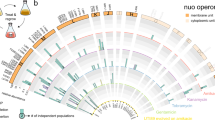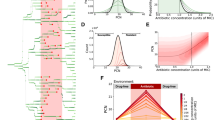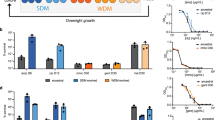Abstract
Multidrug tolerance is largely responsible for chronic infections and caused by a small population of dormant cells called persisters. Selection for survival in the presence of antibiotics produced the first genetic link to multidrug tolerance: a mutant in the Escherichia coli hipA locus. HipA encodes a serine-protein kinase, the multidrug tolerance activity of which is neutralized by binding to the transcriptional regulator HipB and hipBA promoter. The physiological role of HipA in multidrug tolerance, however, has been unclear. Here we show that wild-type HipA contributes to persister formation and that high-persister hipA mutants cause multidrug tolerance in urinary tract infections. Perplexingly, high-persister mutations map to the N-subdomain-1 of HipA far from its active site. Structures of higher-order HipA–HipB–promoter complexes reveal HipA forms dimers in these assemblies via N-subdomain-1 interactions that occlude their active sites. High-persistence mutations, therefore, diminish HipA–HipA dimerization, thereby unleashing HipA to effect multidrug tolerance. Thus, our studies reveal the mechanistic basis of heritable, clinically relevant antibiotic tolerance.
This is a preview of subscription content, access via your institution
Access options
Subscribe to this journal
Receive 51 print issues and online access
$199.00 per year
only $3.90 per issue
Buy this article
- Purchase on Springer Link
- Instant access to full article PDF
Prices may be subject to local taxes which are calculated during checkout






Similar content being viewed by others
References
Lewis, K. Persister cells. Annu. Rev. Microbiol. 64, 357–372 (2010)
Maisonneuve, E. & Gerdes, K. Molecular mechanisms underlying bacterial persisters. Cell 157, 539–548 (2013)
Lewis, K. Persister cells, dormancy and infectious disease. Nature Rev. Microbiol. 5, 48–56 (2007)
Mulcahy, L., Burns, J., Lory, S. & Lewis, K. Emergence of Pseudomonas aeruginosa strains producing high levels of persister cells in patients with cystic fibrosis. J. Bacteriol. 192, 6191–6199 (2010)
Conlon, B. P. et al. Activated ClpP kills persisters and eradicates a chronic biofilm infection. Nature 503, 365–370 (2013)
Moyed, H. S. & Bertrand, K. P. hipA, a newly recognized gene of Escherichia coli K-12 that affects frequency of persistence after inhibition of murein synthesis. J. Bacteriol. 155, 768–775 (1983)
Korch, S. B., Henderson, T. A. & Hill, T. M. Characterization of the hipA7 allele of Escherichia coli and evidence that high persistence is governed by (p)ppGpp synthesis. Mol. Microbiol. 50, 1199–1213 (2003)
Moyed, H. S. & Broderick, S. H. Molecular cloning and expression of hipA, a gene of Escherichia coli K-12 that affects frequency of persistence after inhibition of murein synthesis. J. Bacteriol. 166, 399–403 (1986)
Black, D. S., Irwin, B. & Moyed, H. S. Autoregulation of hip, an operon that affects lethality due to inhibition of peptidoglycan or DNA synthesis. J. Bacteriol. 176, 4081–4091 (1994)
Black, D. S., Kelly, A. J., Mardis, M. J. & Moyed, H. S. Structure and organization of hip, an operon that affects lethality due to inhibition of peptidoglycan or DNA synthesis. J. Bacteriol. 173, 5732–5739 (1991)
Schumacher, M. A. et al. Molecular mechanisms of HipA-mediated multidrug tolerance and its neutralization by HipB. Science 323, 396–401 (2009)
Schumacher, M. A. et al. Role of unusual P-loop ejection and autophosphorylation in HipA-mediated persistence and multidrug tolerance. Cell Rep. 2, 518–525 (2012)
Correia, F. F. et al. Kinase activity of overexpressed HipA is required for growth arrest and multidrug tolerance in Escherichia coli. J. Bacteriol. 188, 8360–8367 (2006)
Germain, E., Castro-Roa, D., Zenkin, N. & Gerdes, K. Molecular mechanism of bacterial persistence by HipA. Mol. Cell 52, 248–254 (2013)
Kaspy, I. et al. HipA-mediated antibiotic persistence via phosphorylation of the glutamyl-tRNA-synthetase. Nature Commun. 4, 3001 (2013)
Yamaguchi, Y. & Inouye, M. Regulation of growth and death in Escherichia coli by toxin–antitoxin systems. Nature Rev. Microbiol. 9, 779–790 (2011)
Balaban, N. Q. Persistence: mechanisms for triggering and enhancing phenotypic variability. Curr. Opin. Genet. Dev. 21, 768–775 (2011)
Hayes, F. & Van Melderen, L. Toxins-antitoxins: diversity, evolution and function. Crit. Rev. Biochem. Mol. Biol. 46, 386–408 (2011)
Rotem, E. et al. Regulation of phenotypic variability by a threshold-based mechanism underlies bacterial persistence. Proc. Natl Acad. Sci. USA 107, 12541–12546 (2010)
Hansen, S., Lewis, K. & Vulić, M. Role of global regulators and nucleotide metabolism in antibiotic tolerance in Escherichia coli. Antimicrob. Agents Chemother. 52, 2718–2726 (2008)
Maisonneuve, E., Shakespeare, L. J., Jorgensen, M. G. & Gerdes, K. Bacterial persistence by RNA endonucleases. Proc. Natl Acad. Sci. USA 108, 13206–13211 (2011)
Shilling, J. D. & Hultgren, S. J. Recent advances into the pathogenesis of recurrent urinary tract infections: the bladder as a reservoir for uropathogenic Escherichia coli. Int. J. Antimicrob. Agents 19, 457–460 (2002)
Blango, M. G. & Mulvey, M. A. Persistence of uropathogenoic Escherichia coli in the face of multiple antibiotics. Antimicrob. Agents Chemother. 54, 1855–1863 (2010)
Mysorekar, I. U. & Hultgren, S. J. Mechanisms of uropathogenic Escherichia coli persistence and eradication from the urinary tract. Proc. Natl Acad. Sci. USA 103, 14170–14175 (2006)
Campbell, E. A., Westblade, L. F. & Darst, S. E. Regulation of bacterial RNA polymerase sigma activity: a structural perspective. Curr. Opin. Struct. Biol. 11, 121–127 (2008)
Murakami, K. S. & Darst, S. A. Bacterial RNA polymerases: the wholo story. Curr. Opin. Struct. Biol. 13, 31–39 (2003)
Murakami, K. S., Masuda, S., Campbell, E. A., Muzzin, O. & Darst, S. A. Structural basis of transcription initiation: an RNA polymerase holoenzyme-DNA complex. Science 296, 1285–1290 (2002)
Feklistov, A. & Darst, S. A. Structural basis for promoter −10 element recognition by the bacterial RNA polymerase σ subunit. Cell 147, 1257–1269 (2011)
LaFleur, M. D., Qi, Q. & Lewis, K. Patients with long-term oral carriage harbor high persister mutants of Candida albicans. Antimicrob. Agents Chemother. 54, 39–44 (2010)
Keren, I., Shah, D., Spoering, A., Kaldalu, N. & Lewis, K. Specialized persister cells and the mechanism of multidrug tolerance in Escherichia coli. J. Bacteriol. 186, 8172–8180 (2004)
Shah, D. V. et al. Persisters: a distinct physiological state of E. coli. BMC Microbiol. 6, 53–62 (2006)
Miller, J. H. A Short Course in Bacterial Genetics 357–364 (Cold Spring Harbor Laboratory Press, 1992)
Datsenko, K. A. & Wanner, B. L. One-step inactivation of chromosomal genes in Escherichia coli K-12 using PCR products. Proc. Natl Acad. Sci. USA 97, 6640–6645 (2000)
Maisonneuve, E., Shakespeare, L. J., Jørgensen, M. G. & Gerdes, K. Bacterial persistence by RNA endonucleases. Proc. Natl Acad. Sci. USA 108, 13206–13211 (2011)
Zaslaver, A. A. et al. A comprehensive library of fluorescent transcriptional reporters for Escherichia coli. Nature Methods 3, 623–628 (2006)
Ochman, H. & Selander, R. K. Standard reference strains of Escherichia coli from natural populations. J. Bacteriol. 157, 690–693 (1984)
Duriez, P. et al. Commensal Escherichia coli isolates are phylogenetically distributed among geographically distinct human populations. Microbiology 147, 1671–1676 (2001)
Lewis, K. et al. in Biofilms, Infection and Antimicrobial Therapy (eds Pace, J. et al.) 241–256 (Taylor & Francis, 2006)
Keren, L. N. et al. Persister cells and tolerance to antimicrobials. FEMS Microbiol. Lett. 230, 12–18 (2004)
Blango, M. G. & Mulvey, M. A. Persistence of uropathogenic Escherichia coli in the face of multiple antibiotics. Antimicrob. Agents Chemother. 54, 1855–1863 (2010)
Adams, P. D. et al. PHENIX: a comprehensive Python-based system for macromolecular structure solution. Acta Crystallogr. D 66, 213–221 (2012)
Brünger, A. T. et al. Crystallography and NMR System: a new software suite for macromolecular structure determination. Acta Crystallogr. D 54, 905–921 (1998)
Thomas-Chollier, M. et al. RSAT 2011: regulatory sequence analysis tools. Nucleic Acids Res. 39, W86–W91 (2011)
Lundblad, J. R., Laurance, M. & Goodman, R. H. Fluorescence polarization of protein-DNA and protein-protein interactions. J. Mol. Endocrinol. 10, 607–612 (1996)
Ni, L., Tonthat, N. K., Chinnam, N. & Schumacher, M. A. Structures of the Escherichia coli transcription activator and regulator of diauxie, XylR: an AraC DNA-binding family member with a LacI/GalR ligand-binding domain. Nucleic Acids Res. 41, 1998–2008 (2013)
Shlyakhtenko, L. S. et al. Silatrane-based surface chemistry for immobilization of DNA, protein-DNA complexes and other biological materials. Ultramicroscopy 97, 279–287 (2003)
Acknowledgements
We thank the Advanced Light Source and their support staff. The Advanced Light Source is supported by the Director, Office of Science, Office of Basic Energy Sciences, Materials Sciences Division, of the US Department of Energy at the Lawrence Berkeley National Laboratory. We also thank the Broad Institute and funding from the NIAID-GSCID for whole-genome sequencing, and A. E. Stapleton and J. R. Johnson for the UTI E. coli strains. This work was supported by an MD Anderson Trust Fellowship (to M.A.S.), the Welch Foundation (G-0040) and Duke University School of Medicine (to R.G.B.), and by National Institutes of Health grants T-R01 AI085585 and R01 GM061162 and by an Army Research Office instrumentation grant W911NF-09-1-0278 (to K.L.).
Author information
Authors and Affiliations
Contributions
M.A.S. and R.G.B. designed and analysed the structural and biochemical studies. P.B. and K.L. designed and analysed the genetic studies. M.A.S. performed the X-ray crystallographic and biochemical studies. P.B. performed genetic and cell culture studies. S.H. performed the hipBA expression analysis. M.V. assisted with genetic analyses. J.M. performed bioinformatics analyses. N.B.C. purified proteins for structural studies. M.A.S., R.G.B., P.B. and K.L. wrote the manuscript.
Corresponding authors
Ethics declarations
Competing interests
The authors declare no competing financial interests.
Extended data figures and tables
Extended Data Figure 1 Validation of the persister phenotype of the hipAP86L mutant allele.
Comparison of time-dependent survival of isogenic strains of E. coli to 100 μg ml−1 of ampicillin in exponential phase. MV7505 was the original EMS strain with the hipAP86L mutation, ΔhipA and WT hipA in the same background (MV7505 ΔhipA and MV7505 WT), MG1655 (WT) and known high-persister mutant (MG1655 hipA7). Overnight cultures of the strains were diluted 1:100 in fresh medium and, after 1.5 h of growth, treated with 100 μg ml−1 of ampicillin for 6 h. Values are an average of at least three individual biological replicates; error bars, s.d.
Extended Data Figure 2 Electron density maps for HipB–(O1–O2) and HipA–HipB–(O1–O2) promoter complexes.
a, Structure of HipB–(O1–O2) complex showing the final refined structure and composite omit map (blue mesh), contoured at 0.9σ and calculated to 3.35 Å resolution. b, Fo − Fc omit electron density map (blue mesh) contoured at 3.5σ to 3.77 Å resolution for the HipA–HipB–(O1–O2) complex in which the entire DNA molecule had been removed. The protein backbone is shown as white lines.
Extended Data Figure 3 Higher-order HipB–hipBA and HipA–HipB–hipBA promoter complexes are extended.
a, Comparison of HipB–(O1–O2) and HipA–HipB–(O1–O2) structures showing they adopt the same extended conformation. b, Schematic of the DNA site used in AFM experiments examining HipB interaction with O1–O2–O3–O4. The 5′ and 3′ DNA ends have an extra 88 bp and 299 bp, respectively, allowing for their differentiation. c, Possible models for HipB–promoter structures. Left: the wrapped model; right: the extended model, which has no cross-HipB contacts. In the wrapped model, the closely apposed HipB molecules would appear as a single ‘blob’ (indicated by dashed green line) bound to fish-hook DNA. In the extended, ‘beads-on-a-string’ model, the HipB dimers bound to O1–O2 and O3–O4 would be close in space, even if on opposite faces of the DNA; hence, given the resolution of AFM, they would appear as single dots on extended DNA. d, AFM images of HipB bound to the DNA schematized in b. The right panel shows two magnified images. HipB dimers bound to closely spaced O1–O2 or O3–O4 are observed as single dots (indicated by arrows), consistent with the extended model. The longer 3′ end is evident in these images.
Extended Data Figure 4 P-loop ejection in HipA higher-order promoter complexes.
The HipA–HipB–(O1–O2) complex is coloured cyan and two phosphorylated HipA (pHipA) molecules, in which Ser150 is phosphorylated (shown as spheres) and the loop ejected from the active site pocket, are coloured yellow and beige. In pHipA the ejected P-loops stabilize the formation of the activation loops. When the pHipA molecules are overlaid onto the promoter-bound HipA dimer, the ejected P-loops and the activation regions from neighbouring molecules would clash unless they were to adopt a different structure or conformation.
Extended Data Figure 5 HipA N-subdomains-1 mediate dimerization in the HipA–HipB–promoter complex.
a, Comparison of apo HipA with promoter complexed HipA showing that the high-persistence hotspot region in HipA mediates dimerization. Left: ribbon diagram of apo HipA with N-subdomain-1 shown as a red surface, and the location of mutations causing high-persistence coloured grey and circled. Right: HipA–HipB–(O1–O2) promoter structure. DNA operator sites are coloured yellow, HipB dimers are coloured cyan and HipA molecules are coloured red and magenta. The red HipA is shown in the same orientation as the apo HipA to the left. The N-subdomain-1 high-persistence hotspot region is circled as in the apo structure. Note, this region forms the centre of HipA dimerization in the higher-order complex. b, Sigma-A-weighted 2Fo − Fc map showing a close up of residues in the HipA interface in the complex. The map is contoured at 0.8σ and calculated to 3.77 Å. Left: close up of the locations of Pro86 and Asp88 in the dimer interface. Right: location of Gly22 in the structure. The two-fold related Gly22 residues directly abut, indicating that any residue other than glycine would not allow stable formation of this dimer.
Extended Data Figure 6 HipA contacts to DNA in the HipA–HipB–promoter complex.
a, HipA–HipB–(O1–O2) complex with the DNA shown as an orange cartoon, HipB dimers as cyan ribbons and HipA molecules as electrostatic surface representations. The blue and red surfaces of HipA correspond to electropositive and electronegative regions, respectively. The HipA regions in proximity to DNA are strikingly electropositive. b, HipA–HipB–(O1–O2) complex with DNA and HipB dimers shown and coloured as in a. HipA molecules are shown as yellow ribbons, with DNA interacting residues shown as spheres, coloured blue and labelled for one HipA subunit.
Extended Data Figure 7 HipA dimers form in the HipA–HipB–(O2–O3) complex.
a, Structure of the HipA–HipB–(O2–O3) complex. The overall structure is shown at the bottom of the panel, with the two HipA molecules depicted as red lines and the HipB dimers as green lines. The DNA is shown as sticks. The O2 and O3 operators are connected by a 21 bp linker, which is disordered in the structure. This is illustrated by the 2Fo − Fc map (blue mesh) contoured at 1.0σ to 3.99 Å, shown in the same orientation as the structure below. b, Comparison of the HipA–HipB–(O1–O2) and HipA–HipB–(O2–O3) complexes showing that they have identical higher-order structures in which the HipA monomers (red and pink) are brought into proximity to form the same dimer when complexed with HipB dimers and O1–O2 or O2–O3 promoter regions.
Extended Data Figure 8 Schematic showing the results of the bioinformatic identification of the −35/−10 boxes of hipBA promoters in Gram-negative bacteria.
The predicted promoters, their operator arrangement and the locations of the −35/−10 boxes for each bacterial species (labelled to the left) are shown. The consensus HipB binding sequence is shown in red above the O1 operator site of the E. coli (MG1655) hipBA promoter. The transcription start site (ATG) is also shown for reference.
Supplementary information
Supplementary Information
This file contains Supplementary Table 1. (PDF 82 kb)
Rights and permissions
About this article
Cite this article
Schumacher, M., Balani, P., Min, J. et al. HipBA–promoter structures reveal the basis of heritable multidrug tolerance. Nature 524, 59–64 (2015). https://doi.org/10.1038/nature14662
Received:
Accepted:
Published:
Issue Date:
DOI: https://doi.org/10.1038/nature14662
This article is cited by
-
Construction of the genetic switches in response to mannitol based on artificial MtlR box
Bioresources and Bioprocessing (2023)
-
The Potential Role of Persister Cells in Urinary Tract Infections
Current Urology Reports (2023)
-
Mutations in respiratory complex I promote antibiotic persistence through alterations in intracellular acidity and protein synthesis
Nature Communications (2022)
-
Immunosuppression broadens evolutionary pathways to drug resistance and treatment failure during Acinetobacter baumannii pneumonia in mice
Nature Microbiology (2022)
-
A genome-wide atlas of antibiotic susceptibility targets and pathways to tolerance
Nature Communications (2022)
Comments
By submitting a comment you agree to abide by our Terms and Community Guidelines. If you find something abusive or that does not comply with our terms or guidelines please flag it as inappropriate.



